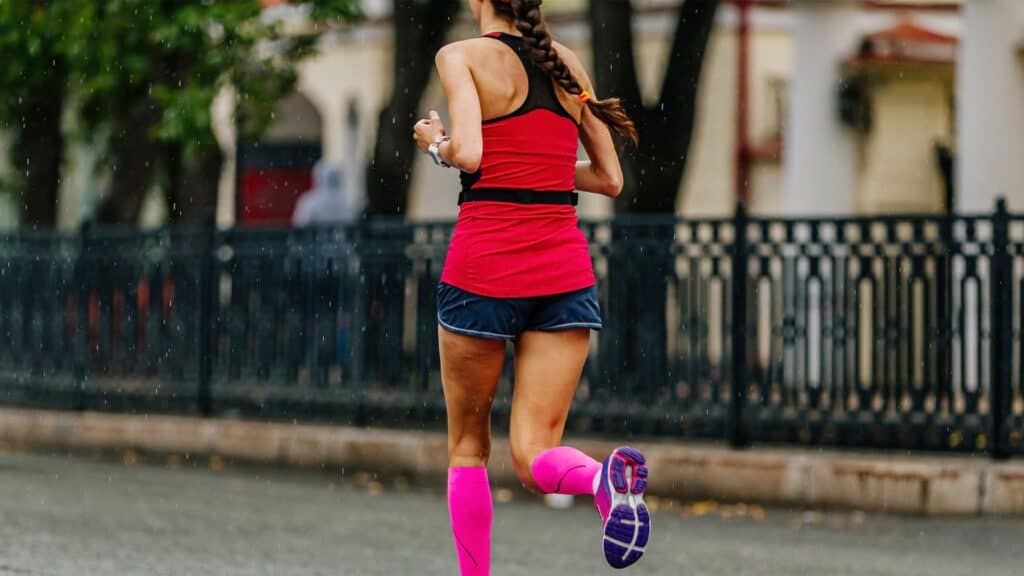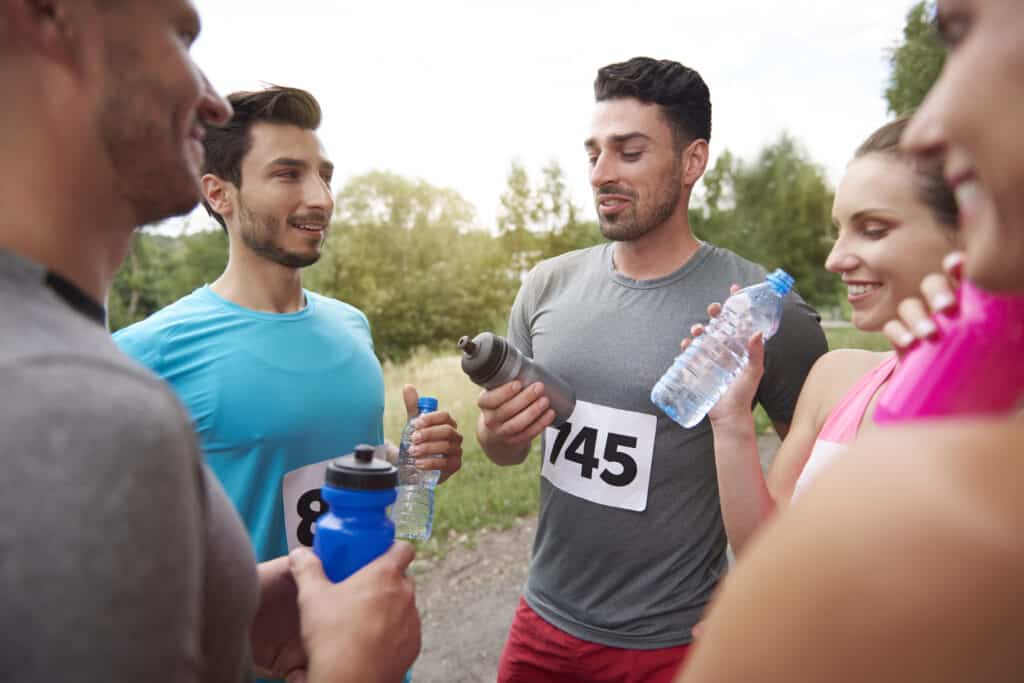The Berlin Marathon is almost here, and runners from all over the world are gearing up for the 42.195-kilometer challenge. Staying hydrated is crucial for your performance and feeling great during the race.
But don’t worry about what’s at the water stations along the Berlin Marathon route – we’ve got you covered! You’ll find various drinks and snacks to keep you hydrated and energized.
At different points along the route, they offer water, sports drinks, and special Maurten Fuel products. Some stations even have fruit, tea, and more water. After passing kilometer 33, there’s a cheering point where you’ll get a 0.5-litre bottle of Lichtenauer Mineralwasser Pur. After you finish the race, there are apples, bananas, salted pretzels, and chocolate rolls, with tea and water available.
Plus, you can enjoy a refreshing ERDINGER Alkoholfrei, a non-alcoholic drink with vitamins and a fantastic taste.
So get excited, and let’s find out more about what awaits you at those water stations!
Here’s what we’ll look at:
- Hydration Stations and Refreshment Points
- How To Hydrate For The Berlin Marathon
- How to Do Elite Runners Hydrate For Marathons
- Berlin Marathon Hydration Plan
- Everything You Need To Know About Electrolytes & Salt Tablets During A Marathon
- Berlin Marathon Route Breakdown

Hydration and Fuelling Stops Along the Berlin Marathon Route
Staying hydrated during the Berlin Marathon is crucial to prevent dehydration and ensure peak performance.
To support the runners, hydration stations are thoughtfully placed along the route, offering much-needed water and sports drinks.
Let’s take a closer look at the drinks and fuel options available during the marathon. Understanding these choices will help you plan how to stay energized and hydrated throughout the race.
Refreshment Points:
Stay refreshed at key kilometers, including 9, 15, 20, 25, 30, and 36, where you’ll find a variety of options like fruit, tea, and water.
Additionally, water-only refreshment points are available at kilometers 5, 12, 17.5, 22.5, 27.5, 32.5, 34.5, 38, and 40.
Lichtenauer Mineralwasser
Around kilometer 33, the Lichtenauer Cheeringpoint at Olivaer Platz awaits, providing a boost of encouragement.
After crossing the finish line, you’ll receive a 0.5-litre bottle of Lichtenauer Mineralwasser Pur in your finishing bag.
Maurten Fuel
Maurten Fuel products are available at kilometers 9, 15, 20, 25, 27.5, 30, and 36. Maurten is known for its effective carbohydrate fueling solutions, that enhance performance and minimize gastrointestinal issues.
Refreshments at the Finish
Congratulations on finishing the marathon! Enjoy a well-deserved treat with apples, bananas, salted pretzels, and chocolate rolls.
Refreshing tea and water will also be available at the finish line.
ERDINGER Alkoholfrei
For a refreshing, non-alcoholic option, try ERDINGER Alkoholfrei. This thirst-quencher delights with spicy malt notes and a slightly sweet taste.
Brewed with natural ingredients according to the Bavarian Purity Law, it supports regeneration with vitamins B9 and B12. At only 25 kcal per 100 ml, it’s a guilt-free way to celebrate your accomplishment.
To optimize your performance, remember to stick to your planned fueling and hydration strategy.
Stop only for drinks and fuel, as you have planned in your training.
NO TRYING NEW THINGS ON RACE DAY!
While the Berlin Marathon provides ample hydration and fuel options along the route, it’s crucial to develop a strategy that works best for you. To optimize your performance, let’s look at the experts’ recommended approach to marathon hydration.

How To Hydrate For The Berlin Marathon
Ensuring proper hydration during exercise is vital for multiple reasons.
Firstly, it aids in flushing out waste products produced by working muscles. Secondly, it facilitates the delivery of oxygen and nutrients to muscles, optimizing performance. Additionally, maintaining hydration is crucial for thermal regulation, especially during a marathon.
From the moment you start running, dehydration sets in, as approximately 75% of exercise energy generates heat, leading to fluid loss. Individual water requirements vary based on sweat rate and are influenced by factors such as heat, humidity, and exercise intensity.
To effectively hydrate for a marathon, preparation starts well in advance.
Focus on staying well-hydrated at least 48 hours before the race. Begin sipping around 600 ml of water three to four hours before the start, continuing until your urine is clear. If not clear, consume an additional 400 ml.
Avoid drinking an entire liter just before running to prevent diluting your sodium balance, bloating, and excessive bathroom breaks during the race.
Proper hydration planning ensures peak performance and endurance on the day of your marathon.
How Often You Should Hydrate During a Marathon
To maintain optimal hydration during exercise, aim to consume 400 ml to 800 ml of water per hour, adjusting based on individual factors like thirst, exercise intensity, and environmental conditions.
During your training, especially on long runs, determine your body’s specific water needs by monitoring weight changes before and after a run.
Ensure you haven’t lost more than 2 percent of your body weight and check the colour of your urine. Light straw or very light yellow color indicates proper hydration, while darker or orangey urine may indicate dehydration.
If dehydrated, consume fluids with a high sodium content and wait 20 to 30 minutes before running.
For runners who have the opportunity, pre-hydrating before a run is beneficial, even though it may not be feasible for morning runners.
If possible, aim to consume about 500 ml of fluid an hour before your run to enhance hydration.
Having some fluid in the stomach helps the body distribute it more effectively during the run to the necessary areas. This residual volume of fluid can optimize performance and ensure a more comfortable and successful running experience.
How to Do Elite Runners Hydrate For Marathons
Research conducted on London Marathon participants revealed that despite organizers providing advice on avoiding hyponatremia, 12% of runners still planned to consume fluid levels that put them at risk. Surprisingly, 93% of participants acknowledged reading and understanding the provided hydration information package.
Hyponatremia is a condition where the blood’s sodium level becomes too low due to excessive water retention, causing symptoms like nausea, headaches, confusion, and fatigue.
Elite athletes adopt a hydration strategy of drinking every 5km and consuming gels around the 10-15km and 25-30km marks.
However, this aggressive approach requires careful monitoring of fluid quantities to prevent hyponatremia.
If you choose to consume gels, do so with water to aid digestion.
Berlin Marathon Hydration Plan
Hydration Before The Marathon:
To avoid the risk of hyponatremia, avoid excessive water consumption leading up to the race.
Instead, opt for an electrolyte drink the night before to enhance blood plasma volume.
Aim to drink about 2-3 ml per pound of body weight at least 4 hours before your run.
Hydration During The Marathon:
Personalizing your hydration strategy is crucial, as sodium loss in sweat varies among individuals.
Merely drinking water over extended periods can dilute sodium levels, affecting performance and potentially leading to hyponatremia.
While there are regular drink stations on the course, it’s not necessary to stop at stations.
Consider your fluid intake during long training runs and aim to replicate it during the marathon, adjusting based on thirst and environmental conditions.
Stick to your planned drinking and fueling schedule from your training to maintain a consistent and effective hydration plan during the race.

Everything You Need To Know About Electrolytes & Salt Tablets During A Marathon
For most marathon runners, salt tablets are generally not necessary, except in extreme endurance events conducted in hot and humid conditions.
Sports drinks with a pinch of salt are typically sufficient to maintain electrolyte balance.
Sports drinks usually contain 23 to 69 milligrams of sodium per deciliter, providing adequate electrolyte replenishment without excessive supplementation.
To supplement electrolytes further, consider consuming salty snacks like biscuits, nuts, or pretzels.
Individuals on a Keto diet, those taking diuretic medication for blood pressure, or anyone with a stomach bug should pay closer attention to electrolyte intake due to increased electrolyte loss.
Symptoms Of Low Electrolyte Levels
Symptoms of low electrolyte levels may include:
- nausea,
- excessive tiredness,
- weakened muscles, and
- spasms.
If you experience these symptoms, consider taking electrolytes, adding salt to your water, and consuming plant foods rich in electrolytes like bananas, greens, nuts, and seeds.
With a clear understanding of what awaits you at the water tables along the Berlin Marathon route, let’s delve into the mile-by-mile breakdown to help you plan your hydration strategy effectively.
Berlin Marathon Route Breakdown
Start Line
The Berlin Marathon starts at Straße des 17. Juni, between Brandenburg Gate and the Victory Column. The elevation at this point is approximately 34 meters (111 feet) above sea level, providing a solid starting position for runners.
Miles 1-3:
This early section of the race is relatively flat, allowing participants to find their rhythm. Runners pass through the Victory Column.
The course then turns at ErnstReuterPlatz towards Tiergarten, one of the largest urban parks in Germany, providing runners with some much-needed greenery and space.
Miles 4-8:
As the runners approach the seventh mile of the Berlin Marathon, the course takes a slight detour to the southern banks of the Spree River, bringing them close to the iconic Reichstag, Germany’s esteemed government building.
The sight of this historic landmark serves as a reminder of the city’s political significance.
Continuing, the athletes find themselves passing by the majestic Berlin Cathedral, also known as the Berliner Dom. This architectural gem stands as a testament to Berlin’s rich history and serves as a picturesque backdrop for the runners.
Moving forward, the course leads them through the bustling Alexanderplatz, a vibrant square that serves as one of the city’s largest transportation hubs.
Here, the runners will encounter the famous World Clock, a popular meeting point, and the imposing TV Tower (Fernsehturm), which offers panoramic views of the city. The Red City Hall (Rotes Rathaus), with its striking red-brick facade, also graces the surroundings, adding to the allure of this dynamic square.
Miles 9-14:
After the 15-km (9.3-mile) mark, runners reach the infamous Kottbusser Tor, famous for its nightlife, street bars, and lively atmosphere. They go towards the district of Kreuzberg, which has a reputation for celebrating multiculturalism, creativity, and street art.
The course has a slight incline during this section, providing runners with a challenge while also making it an enjoyable experience.
Miles 15-23:
After reaching the 25-km mark (approximately 15.5 miles), the Berlin Marathon course presents an interesting challenge for the runners.
For the next 500 meters, the route descends, offering a brief respite and a chance to regain momentum. However, this relief is short-lived as the course sharply inclines for the following 2 km (around 1.2 miles).
This steep ascent puts the athletes’ strength and determination to the test.
From this point on, the runners face a series of alternating short downhill and uphill sections for the next 10 kilometers (approximately 6.2 miles).
These undulating hills add a layer of complexity to the race, requiring the runners to constantly adapt their pace and effort.
The mental fortitude to navigate these challenging terrains and the physical resilience to maintain a strong stride are crucial factors in achieving success.
Overall, despite the presence of these demanding sections, the marathon route gradually declines as the race progresses towards the final stretch.
This gradual descent can provide a welcome relief for the participants, allowing them to push harder and maintain their pace in the closing stages of the race.
Miles 24-26.2:
The final miles of the Berlin Marathon route are marked by a sense of triumph and determination. Runners enter the beautiful Tiergarten, a vast green oasis that provides a refreshing atmosphere.
As they approach the finish line, they make their way back to the iconic Brandenburg Gate, where the crowd’s cheers and the sight of the gate inspire a final surge of adrenaline.
Noteworthy landmarks just before the finish line include the green expanse of Tiergarten and the grand Straße des 17. Juni (refers to the 17 June 1953 uprising in East Germany), which leads the athletes back to the Brandenburg Gate, which serves as a magnificent backdrop for their ultimate accomplishment.




Comments are closed.